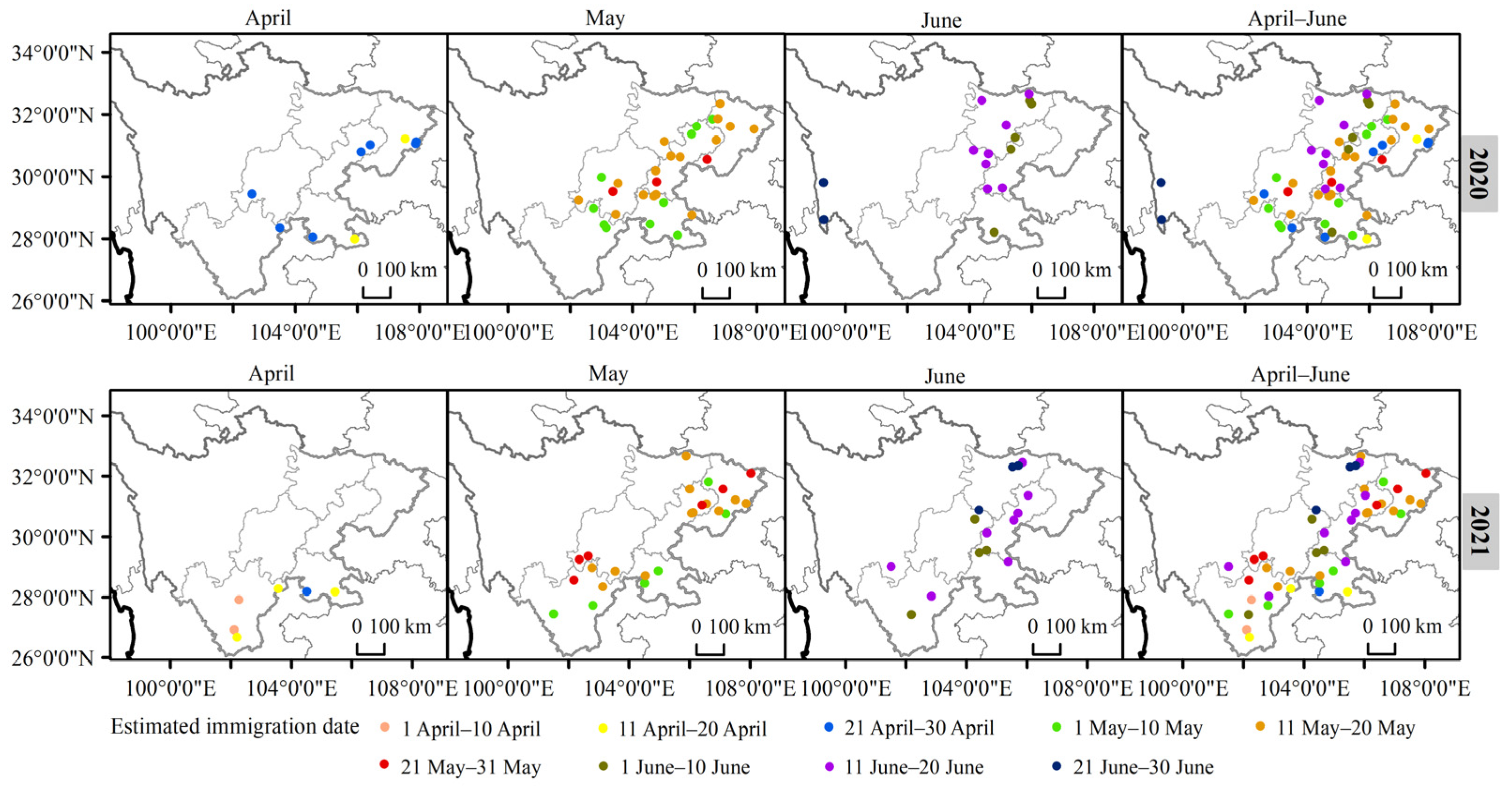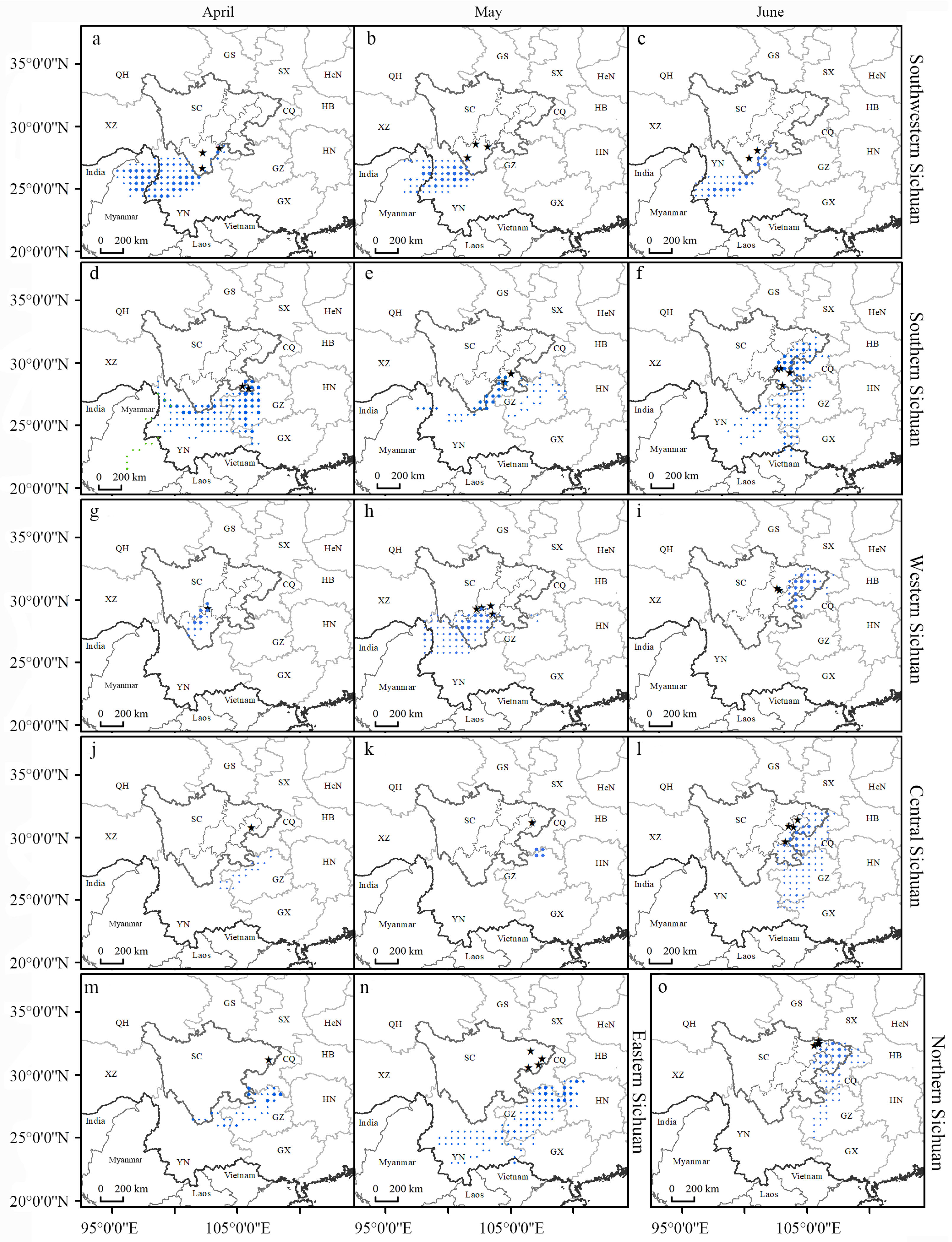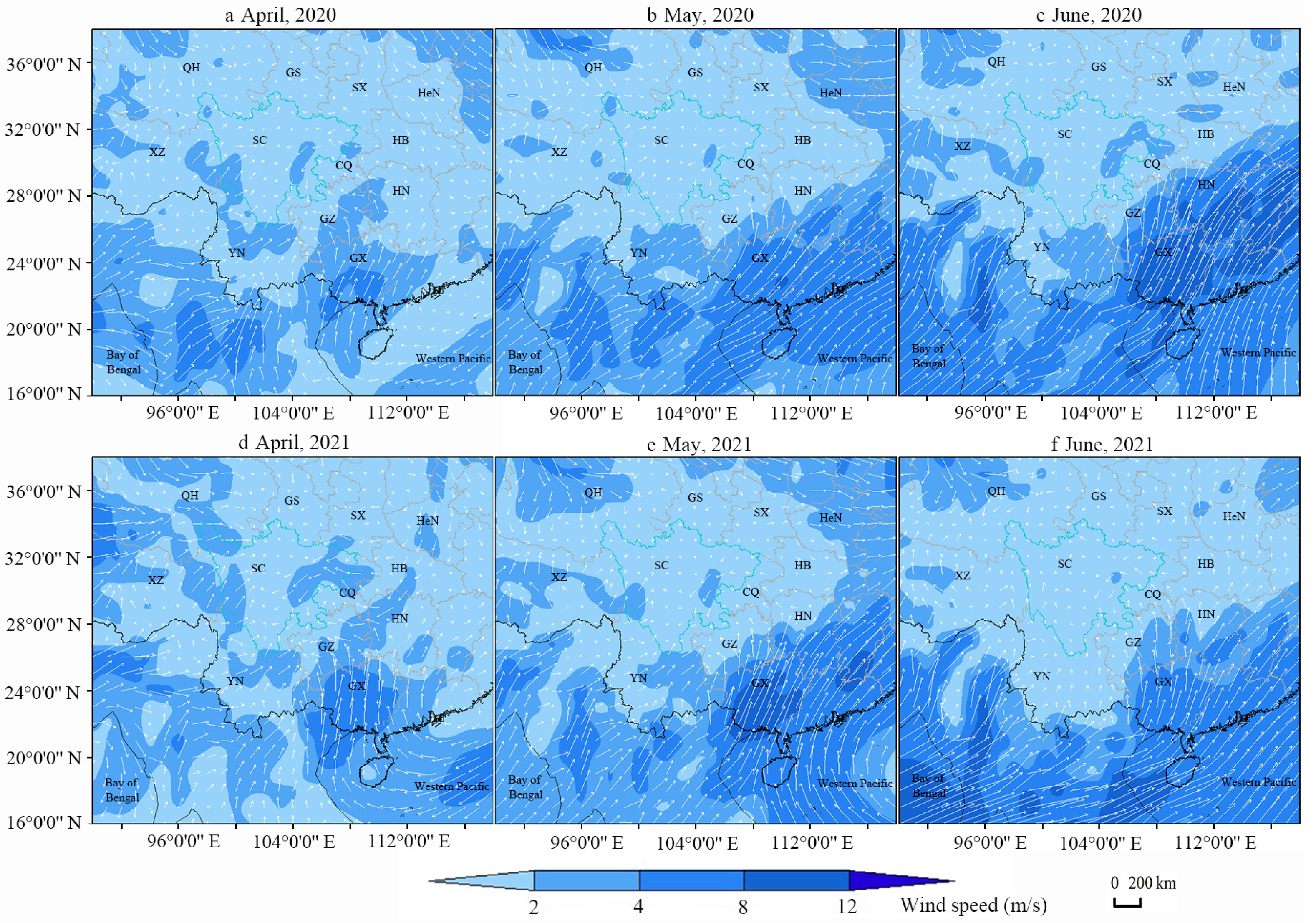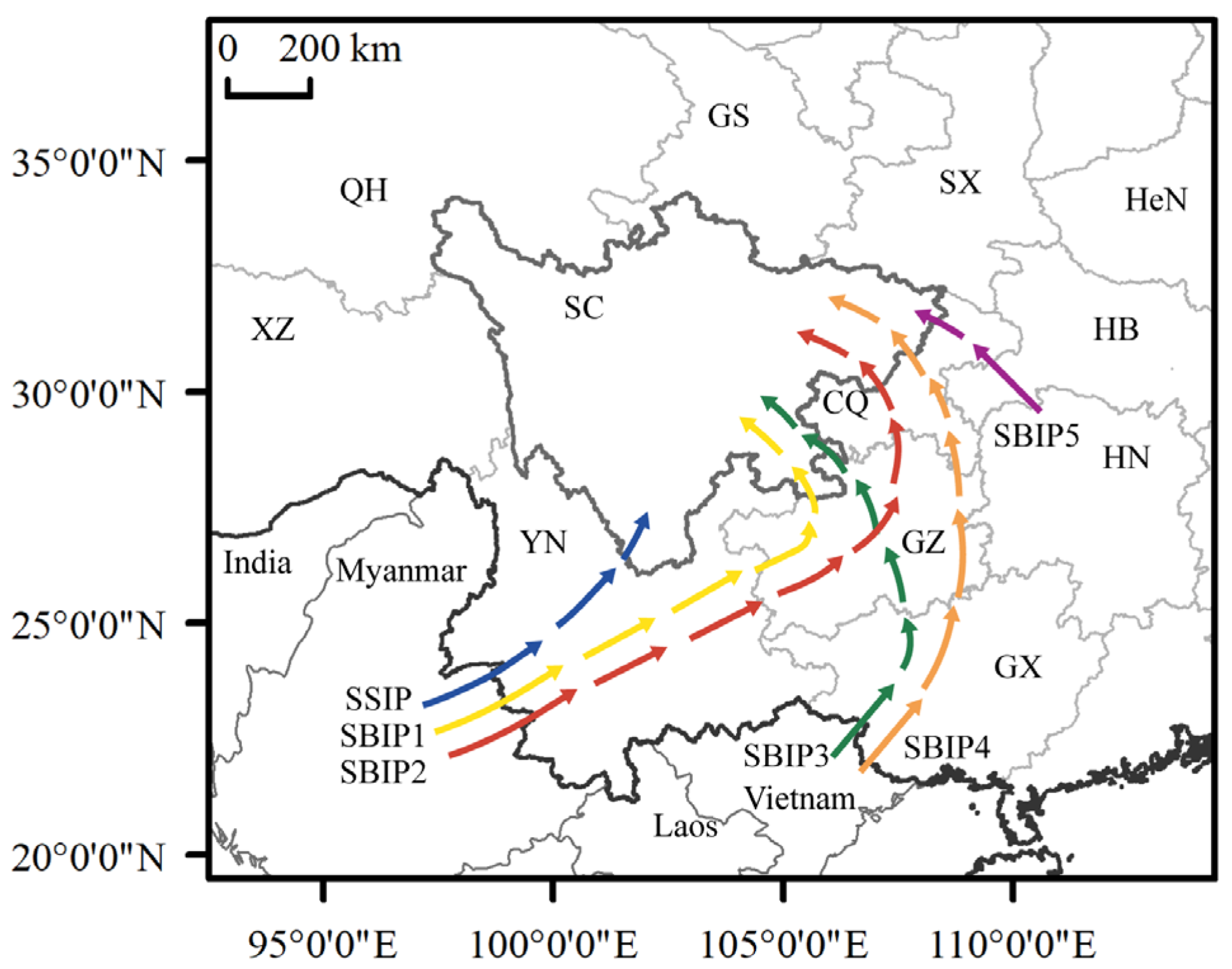The Source Areas and Migratory Pathways of the Fall Armyworm Spodoptera frugiperda (Smith) in Sichuan Province, China
Abstract
Simple Summary
Abstract
1. Introduction
2. Materials and Methods
2.1. Data Sources
2.2. Migration Dynamics Analysis
2.3. Migration Trajectory Analysis
2.4. Meteorological Background Analysis
3. Results
3.1. Migration Dynamics of FAW in Sichuan
3.2. Source Areas of FAW Migrating to Sichuan
3.3. Wind Field Analysis during FAW Migration
3.4. Migratory Pathways of FAW
4. Discussion
Supplementary Materials
Author Contributions
Funding
Data Availability Statement
Acknowledgments
Conflicts of Interest
References
- Sparks, A.N. A review of the biology of the fall armyworm. Fla. Entomol. 1979, 62, 82–87. [Google Scholar] [CrossRef]
- Nagoshi, R.N.; Meagher, R.L. Review of fall armyworm (Lepidoptera: Noctuidae) genetic complexity and migration. Fla. Entomol. 2008, 91, 546–554. [Google Scholar] [CrossRef]
- Montezano, D.G.; Specht, A.; Sosa-Gomez, D.R.; Roque-Specht, V.F.; Sousa-Silva, J.C.; Paula-Moraes, S.V.; Peterson, J.A.; Hunt, T.E. Host plants of Spodoptera frugiperda (Lepidoptera: Noctuidae) in the Americas. Afr. Entomol. 2018, 26, 286–300. [Google Scholar] [CrossRef]
- Westbrook, J.K.; Nagoshi, R.N.; Meagher, R.L.; Fleischer, S.J.; Jairam, S. Modeling seasonal migration of fall armyworm moths. Int. J. Biometeorol. 2016, 60, 255–267. [Google Scholar] [CrossRef]
- Wang, R.L.; Jiang, C.X.; Guo, X.; Chen, D.D.; You, C.; Zhang, Y.; Wang, M.T.; Li, Q. Potential distribution of Spodoptera frugiperda (J.E. Smith) in China and the major factors influencing distribution. Glob. Ecol. Conserv. 2020, 21, e00865. [Google Scholar] [CrossRef]
- Jiang, C.X.; Zhang, X.Y.; Xie, W.Q.; Wang, R.L.; Feng, C.H.; Ma, L.; Li, Q.; Yang, Q.F.; Wang, H.J. Predicting the potential distribution of the fall armyworm Spodoptera frugiperda (J.E. Smith) under climate change in China. Glob. Ecol. Conserv. 2022, 33, e01994. [Google Scholar] [CrossRef]
- Zhou, Y.; Wu, Q.L.; Zhang, H.W.; Wu, K.M. Spread of invasive migratory pest Spodoptera frugiperda and management practices throughout China. J. Integr. Agric. 2021, 20, 637–645. [Google Scholar] [CrossRef]
- Jiang, Y.Y.; Liu, J.; Zhu, X.M. Analysis on the occurrence dynamics and future trend of fall armyworm invading China. China Plant Prot. 2019, 39, 33–35. [Google Scholar] [CrossRef]
- Jing, D.P.; Guo, J.F.; Jiang, Y.Y.; Zhao, J.Z.; Sethi, A.; He, K.L.; Wang, Z.Y. Initial detections and spread of invasive Spodoptera frugiperda in China and comparisons with other noctuid larvae in cornfields using molecular techniques. Insect Sci. 2020, 27, 780–790. [Google Scholar] [CrossRef] [PubMed]
- Ministry of Agriculture and Rural Affairs of the People’s Republic of China. Announcement No. 333 of the Ministry of Agriculture and Rural Affairs of the People’s Republic of China. Available online: http://www.moa.gov.cn/govpublic/ZZYGLS/202009/t20200917_6352227.htm (accessed on 15 September 2020).
- Li, X.J.; Wu, M.F.; Ma, J.; Gao, B.Y.; Wu, Q.L.; Chen, A.D.; Liu, J.; Jiang, Y.Y.; Zhai, B.P.; Early, R.; et al. Prediction of migratory routes of the invasive fall armyworm in eastern China using a trajectory analytical approach. Pest Manag. Sci. 2020, 76, 454–463. [Google Scholar] [CrossRef] [PubMed]
- Jiang, Y.Y.; Liu, J.; Wu, Q.L.; Ciren, Z.G.; Zeng, J. Investment on winter breeding and overwintering areas of Spodoptera frugiperda in China. Plant Prot. 2021, 47, 212–217. [Google Scholar] [CrossRef]
- Wu, Q.L.; Jiang, Y.Y.; Hu, G.; Wu, K.M. Analysis on spring and summer migration routes of fall armyworm (Spodoptera frugiperda) from tropical and southern subtropical zones of China. Plant Prot. 2019, 45, 1–9. [Google Scholar] [CrossRef]
- Wu, Q.L.; Jiang, Y.Y.; Wu, K.M. Analysis of migration routes of the fall armyworm Spodoptera frugiperda (J.E.Smith) from Myanmar to China. Plant Prot. 2019, 45, 1–6. [Google Scholar] [CrossRef]
- Chen, H.; Wu, M.F.; Liu, J.; Chen, A.D.; Jiang, Y.Y.; Hu, G. Migratory routes and occurrence divisions of the fall armyworm Spodoptera frugiperda in China. J. Plant Prot. 2020, 47, 747–757. [Google Scholar] [CrossRef]
- Bi, J.C.; Chen, X.L.; Jiang, C.X.; Li, Q.; Feng, C.H.; Ma, L.; Wang, H.J.; Yang, Q.F. Origins and migration pathways of white-backed planthopper Sogatella furcifera (Horváth) in Sichuan. Acta Ecol. Sin. 2017, 37, 1832–1843. [Google Scholar] [CrossRef][Green Version]
- Guan, L.; Wang, H.J.; Wang, Y.K.; Peng, P.H. Relationship analysis of seed plants’ species variety and topography in Sichuan Province based on GIS. Yangtze River 2016, 47, 11–17. [Google Scholar] [CrossRef]
- Liu, Y.C.; Bi, J.C.; Heng, X.R.; Xin, L.Z.; An, W.; Jiang, C.X. On analysis of source area of White-Backed Plant-hopper (Sogatella furcifera (Horváth)) in early immigration to Miyi, Sichuan. J. Southwest China Norm. Univ. (Nat. Sci. Ed.) 2012, 7, 50–55. [Google Scholar] [CrossRef]
- Bi, J.C.; Chen, X.L.; Peng, X.M.; Feng, C.H.; Ma, L.; Jiang, C.X.; Li, Q.; Wang, H.J.; Yang, Q.F. Source Area and Landing Mechanism of Early Immigration Population of White-backed Planthoppers in Xuyong, Sichuan Province. Chin. J. Rice Sci. 2014, 28, 541–550. [Google Scholar] [CrossRef]
- Xiang, W.W.; Zeng, W.; Chen, X.L.; Jiang, C.X.; Feng, C.H.; Ma, L.; Li, Q.; Yang, Q.F.; Wang, H.J. Source areas and landing mechanisms of the immigration populations of the white-backed planthopper, Sogatella furcifera (Hemiptera: Delphacidae) in eastern Sichuan, southwestern China. Acta Entomol. Sin. 2015, 58, 308–318. [Google Scholar] [CrossRef]
- National White-backed Planthopper Scientific Research Collaborative Group. Studies on the migration of white back planthoppers(Sogatella furcifera horvath). Sci. Agric. Sin. 1981, 14, 25–31. [Google Scholar]
- Zhang, X.Y.; Xie, W.Q.; Wang, R.L.; Feng, C.H.; Wan, X.W.; Ma, L.; Zhang, Y.; Deng, X.Y.; Dong, Y.; Li, Q.; et al. Generation division of the fall armyworm Spodoptera frugiperda (J.E. Smith) in Sichuan province. Plant Prot. 2022, 48, 33–39. [Google Scholar] [CrossRef]
- Zhang, X.Y.; Feng, C.H.; Wan, X.W.; Hu, G.; Li, Q.; Jiang, C.X. The source areas and migration routes of the fall armyworm Spodoptera frugiperda in Sichuan Province in 2019. J. Plant Prot. 2020, 47, 770–779. [Google Scholar] [CrossRef]
- Jiang, C.X.; Chen, X.L.; Bi, J.C.; Li, J.J.; Xiao, X.H.; Li, Q.; Wang, H.J.; Yang, Q.F. Source Areas for the Early Immigration of Sogatella furcifera (Homoptera: Delphacidae) at Xiushan in the Middle Reach of Yangtze River of China. J. Econ. Entomol. 2015, 108, 2789–2799. [Google Scholar] [CrossRef] [PubMed]
- He, L.M.; Ge, S.S.; Chen, Y.C.; Wu, Q.L.; Jiang, Y.Y.; Wu, K.M. The developmental threshold temperature, effective accumulated temperature and prediction model of developmental duration of fall armyworm, Spodoptera frugiperda. Plant Prot. 2019, 45, 18–26. [Google Scholar] [CrossRef]
- Jie, X.D.; Lei, Z.; Xia, C.Y.; Ying; J.Y.; Jie, L.; Fu, J.X. Effect of temperature on flight capacity of the fall armyworm, Spodoptera frugiperda. Plant Prot. 2019, 45, 13–17. [Google Scholar] [CrossRef]
- Zhang, H.M.; Yin, Y.Q.; Zhao, X.Q.; Li, X.Y.; Wang, Y.; Liu, Y.; Chen, F.S.; Chen, A.D. The growth and development characteristics of Spodoptera frugipetda under different temperature conditions. J. Environ. Entomol. 2020, 42, 52–59. [Google Scholar] [CrossRef]
- Jiang, C.X.; Yang, X.L.; Qihui, H.H.; Zhang, Y.H.; Cheng, D.F. A case study of radar observation of the rice leaf folder (Cnaphalocrocis medinalis Guenée) migration in Southern China. Sci. Agric. Sin. 2012, 45, 4808–4817. [Google Scholar] [CrossRef]
- Lu, F.; Zhai, B.P.; Hu, G. Trajectory analysis methods for insect migration research. Chin. J. Appl. Entomol. 2013, 50, 853–862. [Google Scholar]
- Nagoshi, R.N.; Fleischer, S.; Meagher, R.L. Texas is the overwintering source of fall armyworm in central pennsylvania: Implications for migration into the Northeastern United States. Environ. Entomol. 2009, 38, 1546–1554. [Google Scholar] [CrossRef]
- Wolf, W.W.; Westbrook, J.K.; Raulston, J.R.; Pair, S.D.; Lingren, P.D. Radar observations of orientation of noctuids migrating from corn fields in the Lower Rio Grande Valley. Southwest. Entomol. 1995, 20, 45–61. [Google Scholar]
- Farrow, R.A.; Daly, J.C. Long-Range Movements as an Adaptive Strategy in the Genus Heliothis (Lepidoptera, Noctuidae)—A Review of Its Occurrence and Detection in 4 Pest Species. Aust. J. Zool. 1987, 35, 1–24. [Google Scholar] [CrossRef]
- Wu, M.F.; Qi, G.J.; Chen, H.; Ma, J.; Liu, J.; Jiang, Y.Y.; Lee, G.S.; Otuka, A.; Hu, G. Overseas immigration of fall armyworm, Spodoptera frugiperda (Lepidoptera: Noctuidae), invading Korea and Japan in 2019. Insect Sci. 2022, 29, 505–520. [Google Scholar] [CrossRef] [PubMed]
- Wu, Q.L.; Jiang, Y.Y.; Liu, J.; Hu, G.; Wu, K.M. Trajectory modeling revealed a southwest-northeast migration corridor for fall armyworm Spodoptera frugiperda (Lepidoptera: Noctuidae) emerging from the North China Plain. Insect Sci. 2021, 28, 649–661. [Google Scholar] [CrossRef] [PubMed]
- Westbrook, J.; Eyster, R.; Wolf, W.; Lingren, P.; Raulston, J. Migration pathways of corn earworm (Lepidoptera: Noctuidae) indicated by tetroon trajectories. Agric. For. Meteorol. 1995, 73, 67–87. [Google Scholar] [CrossRef]
- Kisimoto, R. Meteorological conditions inducing long-distance immigration of the brown planthopper, Nilaparvata lugens (Stål). Chin. J. Entomol. 1984, 4, 39–48. [Google Scholar]
- Hu, G.; Lu, F.; Lu, M.H.; Liu, W.C.; Xu, W.G.; Jiang, X.H.; Zhai, B.P. The influence of Typhoon Khanun on the return migration of Nilaparvata lugens (Stål) in eastern China. PLoS ONE 2013, 8, e57277. [Google Scholar] [CrossRef] [PubMed]
- Wu, Q.L.; Westbrook, J.K.; Hu, G.; Lu, M.H.; Liu, W.C.; Sword, G.A.; Zhai, B.P. Multiscale analyses on a massive immigration process of Sogatella furcifera (Horvath) in south-central China: Influences of synoptic-scale meteorological conditions and topography. Int. J. Biometeorol. 2018, 62, 1389–1406. [Google Scholar] [CrossRef] [PubMed]
- Hu, G.; Lim, K.S.; Horvitz, N.; Clark, S.J.; Reynolds, D.R.; Sapir, N. Mass seasonal bioflows of high-flying insect migrants. Science 2016, 354, 1584–1587. [Google Scholar] [CrossRef] [PubMed]
- Feng, H.Q.; Wu, K.M.; Ni, Y.X.; Cheng, D.F.; Guo, Y.Y. Return migration of Helicoverpa armigera (Lepidoptera: Noctuidae) during autumn in northern China. Bull. Entomol. Res. 2005, 95, 361–370. [Google Scholar] [CrossRef] [PubMed]
- Feng, H.Q.; Wu, K.M.; Cheng, D.F.; Guo, Y.Y. Radar observations of the autumn migration of the beet armyworm Spodoptera exigua (Lepidoptera: Noctuidae) and other moths in northern China. Bull. Entomol. Res. 2003, 93, 115–124. [Google Scholar] [CrossRef]
- Chapman, J.W.; Drake, V.A.; Reynolds, D.R. Recent Insights from Radar Studies of Insect Flight. Annu. Rev. Entomol. 2011, 56, 337–356. [Google Scholar] [CrossRef] [PubMed]





| Regions | Source Areas | |||||
|---|---|---|---|---|---|---|
| April | May | June | ||||
| Main Source Areas | Other Source Areas | Main Source Areas | Other Source Areas | Main Source Areas | Other Source Areas | |
| southwestern Sichuan | Yunnan (59.60%) Myanmar (40.40%) | — | Yunnan (77.20%) Myanmar (22.80%) | — | Yunnan (97.60%) | Myanmar (2.40%) |
| southern Sichuan | Guizhou (51.41%) Yunnan (36.06%) | Myanmar (8.44%) Guangxi (4.09%) | Yunnan (62.07%) Guizhou (24.83%) Myanmar (13.10%) | — | central Sichuan (32.39%) Guizhou (20.45%) Yunnan (16.80%) Chongqing (15.38%) | eastern Sichuan (8.10%) Guangxi (3.44%) Vietnam (3.44%) |
| western Sichuan | southwestern Sichuan (97.74%) | Yunnan (2.26%) | southwestern Sichuan (72.40%) Yunnan (20.89%) | Myanmar (4.99%) southern Sichuan (1.05%) Guizhou (0.66%) | central Sichuan (53.33%) Chongqing (24.91%) eastern Sichuan (21.75%) | — |
| central Sichuan | Guizhou (77.78%)Yunnan (22.22%) | — | the border of northern Guizhou and Chongqing (100%) | — | Chongqing (49.45%) eastern Sichuan (23.19%) Guizhou (19.01%) | southern Sichuan (5.93%) Guangxi (1.54%) Yunnan (0.88%) |
| eastern Sichuan | Guizhou (76.60%) Yunnan (17.02%) | southwestern Sichuan (6.38%) | Guizhou (49.05%) Hunan (31.33%) Yunnan (15.82%) | Guangxi (2.53%) Vietnam (1.27%) | — | — |
| northern Sichuan | — | — | — | — | eastern Sichuan (41.30%) central Sichuan (33.00%) Chongqing (19.43%) | Guizhou (6.07%) Guangxi (0.20%) |
Publisher’s Note: MDPI stays neutral with regard to jurisdictional claims in published maps and institutional affiliations. |
© 2022 by the authors. Licensee MDPI, Basel, Switzerland. This article is an open access article distributed under the terms and conditions of the Creative Commons Attribution (CC BY) license (https://creativecommons.org/licenses/by/4.0/).
Share and Cite
Jiang, C.; Zhang, X.; Wu, J.; Feng, C.; Ma, L.; Hu, G.; Li, Q. The Source Areas and Migratory Pathways of the Fall Armyworm Spodoptera frugiperda (Smith) in Sichuan Province, China. Insects 2022, 13, 935. https://doi.org/10.3390/insects13100935
Jiang C, Zhang X, Wu J, Feng C, Ma L, Hu G, Li Q. The Source Areas and Migratory Pathways of the Fall Armyworm Spodoptera frugiperda (Smith) in Sichuan Province, China. Insects. 2022; 13(10):935. https://doi.org/10.3390/insects13100935
Chicago/Turabian StyleJiang, Chunxian, Xueyan Zhang, Jiaqi Wu, Chuanhong Feng, Li Ma, Gao Hu, and Qing Li. 2022. "The Source Areas and Migratory Pathways of the Fall Armyworm Spodoptera frugiperda (Smith) in Sichuan Province, China" Insects 13, no. 10: 935. https://doi.org/10.3390/insects13100935
APA StyleJiang, C., Zhang, X., Wu, J., Feng, C., Ma, L., Hu, G., & Li, Q. (2022). The Source Areas and Migratory Pathways of the Fall Armyworm Spodoptera frugiperda (Smith) in Sichuan Province, China. Insects, 13(10), 935. https://doi.org/10.3390/insects13100935







